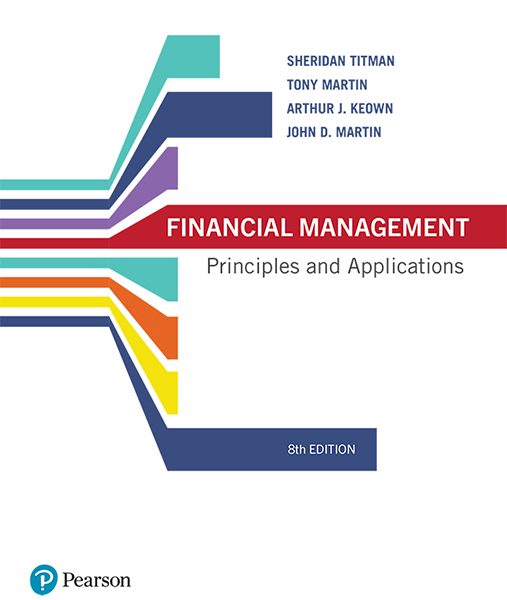Instant download Solution Manual for Financial Management Principles and Applications 8th Australian Edition by Titman pdf docx epub after payment.

Product details:
- ISBN-10 : 148861721X
- ISBN-13 : 978-1488617218
- Author: Sheridan Titman Tony Martin John Martin;
Financial Management is a total learning package that reflects the vitality of an ever-expanding discipline, building on the foundations of economics and accounting.
Adapted for the Australian market, students are presented with a cohesive, inter-related subject that they can use when approaching problems. Building on the strengths of the previous edition, this edition refines content, creating a modern teaching approach.
Five key principles are woven throughout the text using multiple teaching methods, forming a rationalised, coherent, integrated and intuitive problem-solving approach.
Table of contents:
- Part 1 Introduction to financial management
- Chapter 1 Getting started—Principles of finance
- Finance Spotlight Welcome to the world of finance
- 1.1 Finance: an overview
- What is finance?
- Why study finance?
- 1.2 Three types of business organisation
- Sole proprietorship
- Partnership
- Corporation
- How does finance fit into a firm’s organisational structure?
- 1.3 The goal of the financial manager
- Maximising shareholder wealth
- Ethical considerations in corporate finance
- Finance Spotlight Ethical considerations arising from Bond issues
- 1.4 The five basic principles of finance
- Principle 1: Money has a time value
- Principle 2: There is a risk-return trade-off
- Principle 3: Cash flows are the source of value
- Principle 4: Market prices reflect information
- Principle 5: Individuals respond to incentives
- Chapter summary
- Study questions
- Endnotes
- Chapter 2 Firms and the financial market
- Finance Spotlight Superannuation—defined benefit versus defined contribution
- 2.1 The basic structure of the Australian financial markets
- 2.2 The financial marketplace: financial institutions
- Commercial banks: everyone’s financial marketplace
- Non-bank financial intermediaries
- Investment companies
- Finance Spotlight Controlling costs in managed funds
- 2.3 The financial marketplace: securities markets
- How securities markets bring corporations and investors together
- Types of security
- Stock markets
- Finance Spotlight Where’s the money around the world?
- Financial markets and the Global Financial Crisis (GFC)
- Chapter summary
- Study questions
- Endnotes
- Chapter 3 Understanding financial statements, taxes and cash flows
- 3.1 An overview of the firm’s financial statements
- Finance Spotlight Accounting is the language of business
- Basic financial statements
- Why study financial statements?
- What are the accounting principles used to prepare financial statements?
- 3.2 The income statement
- Income statement of H. J. Boswell Ltd
- Connecting the income statement and the balance sheet
- Interpreting firm profitability using the income statement
- IFRS and earnings management
- Checkpoint 3.1 Constructing an income statement
- 3.3 Corporate tax, personal tax and dividend imputation
- Calculating taxable income and company tax payable
- Personal income tax and capital gains tax
- Checkpoint 3.2 Calculation of personal income tax and capital gains tax
- Dividend imputation
- Checkpoint 3.3 Comparison between a classical tax system and a dividend imputation tax system
- 3.4 The balance sheet
- The balance sheet of H. J. Boswell Ltd
- Firm liquidity and net working capital
- Debt and equity financing
- Checkpoint 3.4 Constructing a balance sheet
- Book values, historical costs and market values
- Finance Spotlight Your personal balance sheet and income statement
- 3.5 The cash flow statement
- Sources and uses of cash
- H. J. Boswell’s cash flow statement
- Finance Spotlight IFRS versus GAAP
- Checkpoint 3.5 Interpreting the statement of cash flows
- Chapter summary
- Study questions
- Study problems
- Mini-case
- Endnotes
- Chapter 4 Financial analysis: sizing up firm performance
- Finance Spotlight Financial ratios and business
- 4.1 Why do we analyse financial statements?
- 4.2 Common-size statements: standardising financial information
- The common-size income statement: H. J. Boswell Ltd
- The common-size balance sheet: H. J. Boswell Ltd
- 4.3 Using financial ratios
- Liquidity ratios
- Checkpoint 4.1 Evaluating James Hardie Industries PLC’s liquidity
- Capital structure ratios
- Asset management efficiency ratios
- Checkpoint 4.2 Comparing the financing decisions of Wesfarmers Ltd and Woolworths Ltd
- Profitability ratios
- Checkpoint 4.3 Evaluating the return on assets for Wesfarmers Ltd and Woolworths Ltd
- Market value ratios
- Finance Spotlight Your cash budget and personal savings ratio
- Checkpoint 4.4 Comparing Treasury Wine Estates with Australian Vintage using market value ratios
- Summing up the financial analysis of H. J. Boswell Ltd
- Finance Spotlight Ratios and international accounting standards
- 4.4 Selecting a performance benchmark
- Trend analysis
- Peer-firm comparisons
- 4.5 Limitations of ratio analysis
- Chapter summary
- Study questions
- Study problems
- Mini-case
- Endnotes
- Part 2 Valuation of financial assets
- Chapter 5 The time value of money—The basics
- Finance Spotlight A dollar saved is two dollars earned
- 5.1 Using timelines to visualise cash flows
- Checkpoint 5.1 Creating a timeline
- 5.2 Compounding and future value
- Compound interest and time
- Compound interest and the interest rate
- Techniques for valuing cash flows at different points in time
- Applying compounding to things other than money
- Checkpoint 5.2 Calculating the future value of a cash flow
- Compound interest with shorter compounding periods
- Checkpoint 5.3 Calculating future values using non-annual compounding periods
- Finance Spotlight Saving for your first house
- 5.3 Discounting and present value
- The mechanics of discounting future cash flows
- Checkpoint 5.4 Solving for the present value of a future cash flow
- Discounting with shorter discounting periods
- Two additional types of discounting problem
- The Rule of 72
- Checkpoint 5.5 Solving for the number of periods, n
- Checkpoint 5.6 Solving for the interest rate, i
- 5.4 Making interest rates comparable
- Calculating the interest rate and converting it to an EAR
- Checkpoint 5.7 Calculating an effective annual rate (EAR)
- To the extreme: continuous compounding
- Chapter summary
- Study questions
- Study problems
- Mini-case
- Chapter 6 The time value of money—Annuities and other topics
- Finance Spotlight Annuities we all know
- 6.1 Annuities
- Ordinary annuities
- Checkpoint 6.1 Solving for an ordinary annuity payment
- Checkpoint 6.2 The present value of an ordinary annuity
- Amortised loans
- Checkpoint 6.3 Determining the outstanding balance of a loan
- Annuities due
- Finance spotlight Saving for retirement
- 6.2 Perpetuities
- Calculating the present value of a level perpetuity
- Checkpoint 6.4 The present value of a level perpetuity
- Calculating the present value of a growing perpetuity
- Checkpoint 6.5 The present value of a growing perpetuity
- 6.3 Complex cash-flow streams
- Checkpoint 6.6 The present value of a complex cash-flow stream
- Chapter summary
- Study questions
- Study problems
- Mini-case
- Chapter 7 Risk and return—An introduction: history of financial market returns
- Finance Spotlight Using statistics
- 7.1 Realised and expected rates of return and risk
- Calculating the realised return from an investment
- Calculating the expected return from an investment
- Measuring risk
- Checkpoint 7.1 Evaluating an investment’s return and risk
- 7.2 A brief history of financial market returns
- Australian financial markets: domestic investment returns
- Lessons learned
- Australian shares versus other categories of investment
- Global financial markets: international investing
- Finance Spotlight Determining your tolerance for risk
- 7.3 Geometric versus arithmetic average rates of return
- Calculating the geometric or compound average rate of return
- Choosing the right ‘average’
- Checkpoint 7.2 Calculating the arithmetic and geometric average rates of return
- 7.4 What determines share prices?
- The efficient markets hypothesis
- Do we expect financial markets to be perfectly efficient?
- Market efficiency: what does the evidence show?
- Chapter summary
- Study questions
- Study problems
- Mini-case
- Endnotes
- Chapter 8 Risk and return—Capital market theory
- Finance Spotlight Risk and your personal investment plan
- 8.1 Portfolio returns and portfolio risk
- Calculating the expected return of a portfolio
- Checkpoint 8.1 Calculating a portfolio’s expected rate of return
- Evaluating portfolio risk
- Calculating the standard deviation of a portfolio’s returns
- Finance Spotlight International diversification
- Checkpoint 8.2 Evaluating a portfolio’s risk and return
- 8.2 Systematic risk and the market portfolio
- Diversification and unsystematic risk
- Diversification and systematic risk
- Systematic risk and beta
- Calculating the portfolio beta
- 8.3 The security market line and the CAPM
- Using the CAPM to estimate expected rates of return
- Checkpoint 8.3 Estimating the expected rate of return using the CAPM
- Chapter summary
- Study questions
- Study problems
- Mini-case
- Endnotes
- Chapter 9 Debt valuation and interest rates
- Finance Spotlight Borrow now, pay later
- 9.1 Overview of government and corporate debt
- Borrowing money in the private financial market
- Borrowing money in the public financial market
- Checkpoint 9.1 Calculating the rate of interest on a floating-rate loan
- Basic bond features
- Finance Spotlight Fixed- and variable-rate mortgages
- 9.2 Valuing bonds
- Valuing bonds by discounting future cash flows
- Step 1: Determine bondholder cash flows
- Step 2: Estimate the appropriate discount rate
- Checkpoint 9.2 Calculating the yield to maturity on a corporate bond
- Step 3: Calculate the present value using the discounted cash flow
- Checkpoint 9.3 Valuing a bond issue
- Checkpoint 9.4 Valuing a bond issue that pays semi-annual interest
- 9.3 Bond valuation: four key relationships
- First relationship
- Second relationship
- Third relationship
- Fourth relationship
- 9.4 Types of bond
- Secured versus unsecured
- Priority of claims
- Initial offering market
- Abnormal risk
- Coupon level
- Amortising or non-amortising
- Convertibility
- Finance Spotlight International bonds
- 9.5 Determinants of interest rates
- Inflation and real versus nominal interest rates
- Checkpoint 9.5 Solving for the real rate of interest
- Interest rate determinants: breaking it down
- Checkpoint 9.6 Solving for the nominal rate of interest
- The maturity-risk premium and the term structure of interest rates
- Chapter summary
- Study questions
- Study problems
- Mini-case
- Endnotes
- Chapter 10 Share valuation
- Finance Spotlight Getting your fair share
- 10.1 Ordinary shares
- Characteristics of ordinary shares
- Finance Spotlight Does a share by any other name smell as sweet?
- Agency costs and ordinary shares
- Valuing ordinary shares using the discounted dividend model
- Checkpoint 10.1 Valuing ordinary shares
- 10.2 The comparables approach to valuing ordinary shares
- Defining the price-earnings (P/E) ratio valuation model
- What determines the P/E ratio for a share?
- Checkpoint 10.2 Valuing ordinary shares using the P/E ratio
- An aside on managing for shareholder value
- A word of caution about P/E ratios
- 10.3 Preference shares
- Features of preference shares
- Valuing preference shares
- Checkpoint 10.3 Valuing preference shares
- A quick review: valuing bonds, preference shares and ordinary shares
- Chapter summary
- Study questions
- Study problems
- Mini-case
- Endnotes
People also search:
Financial Management Principles and Applications 8th Australian Edition
Financial Management Principles and Applications 8th Australian Edition pdf
Financial Management Principles and Applications
what are the principles of financial management
|
what are the fundamental principles of financial management |





